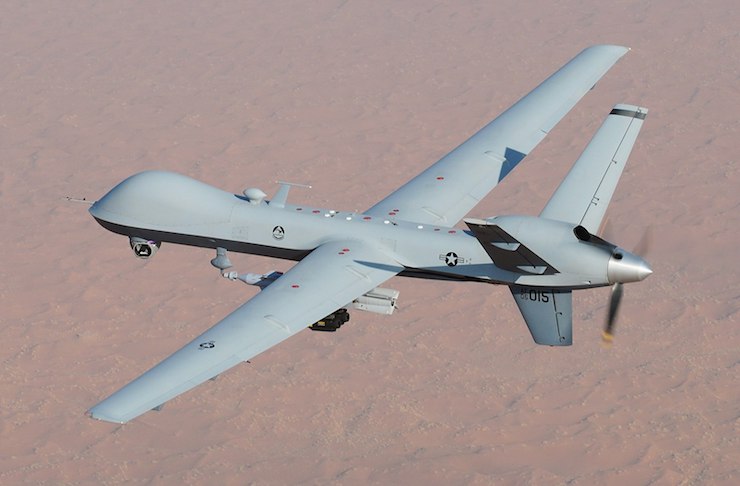
On May 1, 2007 the United States Air Force officially began using the MQ-9 Reaper drone, also known as the Predator B. Developed by General Atomics, the Reaper is a long endurance, high altitude UAV that can be flown remotely or autonomously. In 2006 the Reaper made history as then US Air Force Chief of Staff General T. Michael Moseley announced, “We’ve moved from using UAVs primarily in intelligence, surveillance, and reconnaissance roles before Operation Iraqi Freedom, to a true hunter-killer role with the Reaper.” By the year 2016, the US Air Force had logged over 2 million flight hours with Reaper drones.
For remote flight the Reaper is controlled by a two person team. The first is the pilot responsible for remotely controlling the drone. The second member of the team is the sensor operator who maintains control over all of the drones sensitive equipment like weapons systems and cameras. The drone has a flight range of 1,150 miles. Once it leaves one base, the flight controls can be securely switched over to a coordinating team at another base. While the Reaper is airborne it is also followed by two flanking jets as an over-watch system, until now.
This month the Reaper yet again made drone history as it made it’s first unescorted flight from a commercial airport in the United States. The flight took place at the Syracuse Hancock International Airport in Upstate NY. Syracuse Hancock International Airport (SYR) is a joint civil military airport that transports over a million passengers a year. Hancock Field is the SYR home of the New York Air Guard’s 174th Attack Wing and 274th Support Operations Squadron where 3 Reapers and their 2 chase planes are flown daily. However, having to use an escort for the drones has proven to be restrictive.
Having enough escorts to follow the drones on their daily trips over Lake Ontario for training missions has been one issue. The other is when weather interferes with the escort’s ability to maintain a visual connection with the Reaper. In an effort to solve these inhibitors, SYR has begun using a new radar system developed by SRC, Inc. SRC is a not for profit research and development firm that specializes in radar developments. Their radar system LSTAR has been used by the US military and its allies to protect soldiers and civilians around the world by detecting incoming mortar rounds. But never before had it been used in a setting like SYR.
The new radar system in combination with the radar system used by the FAA is allowing the drones to fly without any escorts to watch out for collisions. The system scans the airport and it’s surrounding areas electronically. It is so precise that it can detect any aircraft in the sky, including hard to see small drones. In fact, the radar system is able to identify possible collision objects better than a pilot in a chaser plane. Once the radar system detects an obstruction it notifies the ground pilot immediately and will even provide evasive maneuvers.
This radar system will go a long way in keeping the skies safe for operators to run test missions with drones. It will also save a lot of money and fuel when chaser planes can be kept grounded. More importantly it is a way of setting a precedent for how drones can operate safely in shared airspace.
|